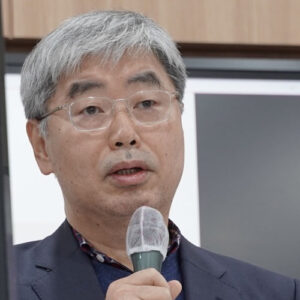 We spoke with Prof. Park Younghwan (Dongguk University) to learn about the materials he is using to carry out his research on “Korean Buddhist texts in the Harvard-Yenching Library’s Korean Rare Book Collection.”
We spoke with Prof. Park Younghwan (Dongguk University) to learn about the materials he is using to carry out his research on “Korean Buddhist texts in the Harvard-Yenching Library’s Korean Rare Book Collection.”
Could you briefly introduce your research project at HYI?
My research aims to investigate the transmission process, characteristics, value, and importance of Korean ancient Buddhist rare books owned by Yenching Library. When studying such ancient books, the preface at the beginning of the book, the epilogue at the end, and a colophon are the most important elements. They contain records of who planned the publication of these ancient books, the reasons and purposes behind it, as well as the meaning and process involved in their publication. The book seal is also crucial as it allows us to identify the owner and understand the provenance of the book. The study of precious Buddhist texts extends beyond the history of the books themselves. It provides insights into the flow of religious and cultural thought during that time. For instance, through the distribution of Buddhist texts, we can observe that the strong policy of advocating Confucianism and suppressing Buddhism, which was implemented during the early Joseon Dynasty, began to crumble in the 18th century. A typical example is the phenomenon in which Confucian scholars in the late Joseon Dynasty actively purchased Buddhist books, which were considered heretical in Joseon, from China.
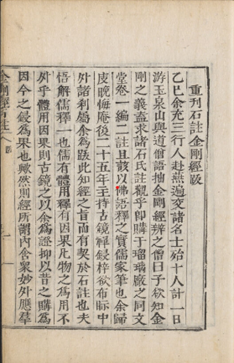
Confucian scholar Lee Yu-won(李裕元), who wrote the epilogue, reveals that he went to the Qing Dynasty as an envoy and purchased 『Kŭnganggyŏng sŏkchu金剛經石註』 from Liulichang in Beijing.
What materials in the Harvard-Yenching Library have been especially helpful for you?
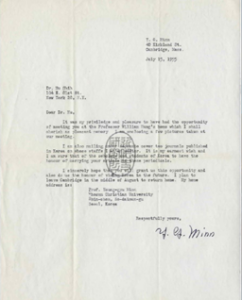
7/15/1955, Min Young-gyu’s first letter to Hu Shih. (Letter provided by Zou Xinming, Peking University)
The Yenching Library is a spring that never runs dry. Just as we are tempted to drink at the sight of pure spring water, the materials in Yenching Library arouse our endless academic enthusiasm. While researching the collection of Min Young-gyu, I was able to secure seven correspondences between Hu Shih and Min Young-gyu. These letters not only confirm the academic exchange between the two men but are also important primary data that prove that Min Young-gyu’s research on the history of Korean Zen Buddhism succeeds Hu Shih’s research. It can also be confirmed that Hu Shih’s visit to Korea was aimed at further studying the history of Zen Buddhism in China on a deeper level. The collection of Bruno Petzold (1873-1949) was also of great assistance. If there are Chinese characters and Japanese on the book seal, most people will assume that it is a Japanese collection. However, I was both excited and confused when I found out that the owner of the book seal was a German, Bruno Petzold, who had nothing to do with Chinese characters and Buddhist images.
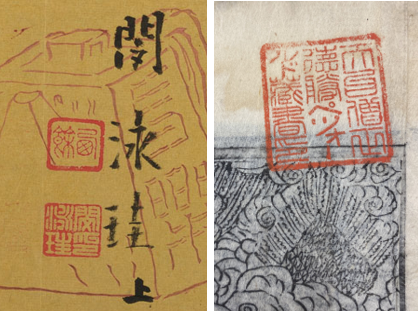
Min Young-gyu’s book seal (left) and Petzold’s book seal (right)
Unlike Korean ancient Buddhist books, the Japanese ancient Buddhist books he owned had a relatively rich and colorful publishing style, which broadened my view of ancient books. I have once again recognized the importance of adopting a research approach that goes beyond preconceived biases and limitations to gain a broader perspective. Therefore, the phrase “hypothesize boldly while proving it carefully,” emphasized by Hu Shih, gives us many implications.
Can you give a few examples of interesting findings in these library materials?
It was very fascinating to discover the differences between Korean and Japanese ancient Buddhist books in terms of publishing culture. In general, most of the ancient Korean literature is in the form of a thread-bound book. The size of the book is almost the same, and the method of tying the book is usually constant with five eyelets. Even if the size of the book varies considerably, most of them are unified with five eyelets. On the other hand, Japanese books exhibit a wide range of diversity.
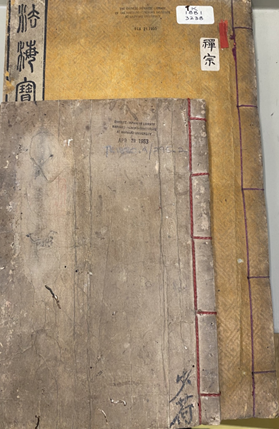
Even to the naked eye, you can see that the two books are clearly different sizes. However, the binding method, with five eyelets, is the same in both books.
There are a wide array of styles such as thread-bound books, scroll style, oriental style, and accordion style, and the size of the book varies from 14cm to about 40cm. It may be due to differences in the materials used to make books, but Japan’s geographic and environmental factors, which are composed of various islands, may also have had a great influence. Ideologically, it may be related to the fact that ancient Japan tolerated relatively diverse ideas, unlike uniform Joseon centered on the Zhu Xi school of Neo-Confucianism. It was also interesting to see that one person had as many as 5-6 different collections of book seals in ancient Buddhist texts. This is due to the inclusion of Confucian practices involving given names, along with the utilization of nicknames and literary names, as well as the Eastern customs encompassing Buddhist names and Taoist names. Comparative research from East Asian perspectives based on diversity helps organize and interpret ancient cultures and literature.
